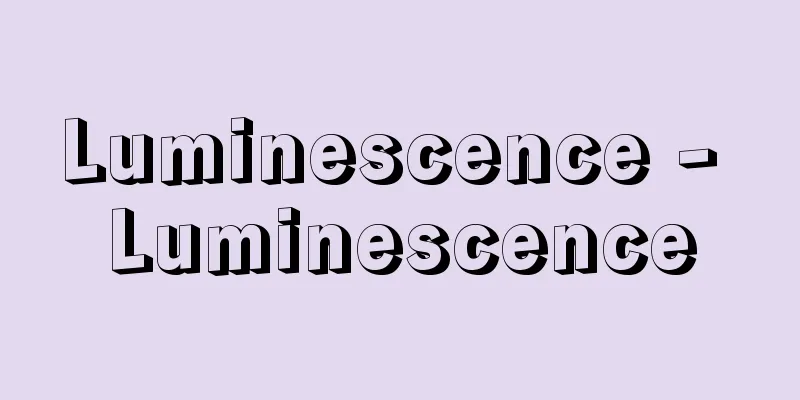Luminescence - Luminescence

|
A luminous phenomenon in which a substance releases part or all of the energy absorbed as light. This refers to a wide range of luminous phenomena that are caused by electrical, chemical, mechanical, biological, and other factors, other than thermal radiation, which is the luminous phenomenon from objects heated to high temperatures, and Cherenkov radiation, which is the luminous phenomenon when charged particles such as alpha particles and protons penetrate a substance. It is sometimes called cold light because it is not as hot as thermal radiation. [Atsunosuke Nakajima October 19, 2016] ClassificationLuminescence is classified according to the way energy is transferred to a substance: (1) Electroluminescence: The phenomenon in which gases, liquids, solids, etc. emit light when an electric field is applied. An example of this is the emission of light accompanying electric discharge. (2) Photoluminescence: Light emitted by irradiation with ultraviolet or visible light, and is the luminescence phenomenon exhibited by most fluorescent and phosphorescent materials. Examples include fluorescent lamps and fluorescent paints. (3) Thermoluminescence: Luminescence that occurs when a phosphor is excited by applying a stimulus, and then the stimulus is removed and the temperature is raised. Thermoluminescence dosimeters (TLDs), which calculate the integral dose of radiation, are an application of this type. (4) Chemiluminescence: This occurs as a result of a chemical reaction. A typical example is the luminescence that occurs during the oxidation of luminol. Bioluminescence, such as the light emitted by fireflies, is also considered to belong to this category. (5) Radioluminescence: This is produced by exposure to high-energy radiation such as X-rays (γ (gamma) rays), electron beams, α rays, and neutron rays. Examples include the luminescence of cathode ray tubes, luminous paints, and the luminescence of sodium iodide scintillation counters used as γ-ray detectors. Other examples include triboluminescence, which is the luminescence that occurs when crystals such as sugar are ground, and sonoluminescence, which occurs when certain solutions are subjected to ultrasound or other forces. [Atsunosuke Nakajima October 19, 2016] Light Emitting MechanismThe time that light emission continues after the stimulus to the substance is stopped is called the decay time, and it is common to distinguish between a shorter decay time as fluorescence and a longer decay time as phosphorescence, but this distinction is not clear-cut. Strictly speaking, fluorescence occurs when the spin multiplicities of the electronic states before and after the emission process accompanying light emission are equal, and phosphorescence occurs when they are different. When sodium or mercury vapor is irradiated with light that corresponds to its intrinsic absorption, the absorbed light is re-emitted reversibly. Absorption that occurs between the ground state and excited state, where a spectral transition is allowed, is called resonance absorption, and emission is called resonance emission, with resonance emission being the simplest case of fluorescence. Even gaseous molecules such as benzene and aniline can emit resonance radiation and show sharp linear fluorescence if their vapor pressure is low enough and collisions between molecules are negligible. However, in many cases, molecules produce band spectra due to intramolecular vibrations and rotations, and collisions with surrounding molecules result in a continuous spectrum. For this reason, the energy of the emitted photon is equal to or smaller than the energy of the photon used for excitation. This phenomenon is called the Stokes shift (Stokes' law). In liquids, the deactivation of excited states is rapid due to the high density and the presence of intense molecular motion. As a result, substances that emit luminescence in a gaseous state no longer emit fluorescence. However, molecules with special structures that make their electronic state less susceptible to the influence of their surroundings (such as fluorescein, anthracene, uranyl salts, and rare earth salts) do fluoresce. These substances also fluoresce when dispersed or adsorbed in glass or polymers. In most cases, external stimuli applied to a solid are converted into thermal motion of atoms within the solid and do not emit light. Therefore, in order to generate luminescence, it is necessary for the solid to be a crystal containing many so-called "active centers". Crystal luminescent materials are the most important luminescent materials, and are broadly divided into pure phosphors, whose fluorescence becomes stronger as their purity increases, and activated phosphors. In the former, point defects such as vacancies become active centers, while in the latter, impurity-substituted atoms become active centers. When such active centers exist, electrons are excited to a certain level by the injected energy. In the excited state, the atomic spacing and lattice change to minimize the energy, that is, the electrons move to a relaxed excited state and emit light. A transition that gives energy to lattice vibrations without emitting light is called a non-radiative transition. Luminescence is a spontaneous emission phenomenon, but if a luminescent material is placed in a resonator and a sufficient stimulus is applied, stimulated emission can occur and laser oscillation can be achieved. [Atsunosuke Nakajima October 19, 2016] Examples of activated phosphorsRepresentative activated phosphors of practical importance are shown below. (1) Sulfide and selenide compounds for cathode ray tubes and EL devices, such as silver-activated zinc sulfide ZnS:Ag and copper-activated calcium selenide CaSe:Cu. (2) Semiconductor elements formed with pn junctions using III-V group compounds on the periodic table for use as light-emitting diodes and semiconductor lasers for optical communications, etc. Gallium arsenide (GaAs), gallium phosphide (GaP), etc. (3) Rare earth compounds that are important as red phosphors for color televisions, such as europium-activated yttrium oxysulfide (YO 2 S:Eu). (4) Alkali halide phosphors such as thallium-activated sodium iodide NaI:Tl, which are used as scintillators for gamma ray measurement. (5) Various oxygen acid phosphors for fluorescent lamps, such as manganese-activated zinc orthosilicate Zn 2 SiO 4 :Mn, cerium-activated calcium phosphate Ca 3 (PO 4 ) 2 :Ce, and manganese-activated magnesium oxide diarsenic pentoxide 6MgO-As 2 O 5 :Mn. (6) Natural minerals such as diamond, corundum, fluorite, and apatite. [Atsunosuke Nakajima October 19, 2016] [References] | | | | | | | |Source: Shogakukan Encyclopedia Nipponica About Encyclopedia Nipponica Information | Legend |
|
物質が吸収したエネルギーの一部または全部を光として放出する発光現象。高温に熱せられた物体からの発光現象である熱放射およびα(アルファ)線や陽子(プロトン)などの荷電粒子が物質中を貫通するときの発光現象であるチェレンコフ放射以外の電気的、化学的、機械的、生物的などのいろいろな原因で発せられる広範な発光現象をさす。熱放射ほど熱くないので冷光とよばれることもある。 [中島篤之助 2016年10月19日] 分類ルミネセンスは物質へのエネルギーの与え方によって次のように分類される。 (1)エレクトロルミネセンス 電場を加えることにより気体・液体・固体などが発光する現象で、放電に伴う発光などがその例である。 (2)光ルミネセンス 紫外線あるいは可視光線の照射により発光するもので、大多数の蛍光体やリン光体の示す発光現象である。蛍光灯や蛍光塗料などがその例である。 (3)熱ルミネセンス 蛍光体に刺激を与えて励起し、その刺激を絶ってから温度を上げたときに生ずるルミネセンス。放射線の積分線量を求める熱蛍光線量計(TLD)はこの応用である。 (4)化学ルミネセンス 化学反応に伴って生ずるもので、ルミノール液の酸化の際の発光はこの代表的な例である。ホタルの光などの生物発光もこれに属するとされている。 (5)放射線ルミネセンス X線(γ(ガンマ)線)、電子線、α線、中性子線など高エネルギー放射線の照射により生ずるもので、ブラウン管の発光、夜光塗料やγ線検出器として用いられるヨウ化ナトリウムシンチレーション計数管の発光などはこの例である。 このほか、砂糖などの結晶を磨砕するときの発光現象である摩擦ルミネセンスや、ある種の溶液に超音波などを作用させると発光する音(おと)ルミネセンスなどがある。 [中島篤之助 2016年10月19日] 発光機構物質への刺激を停止したあとの発光継続時間を減衰時間といい、その短いものを蛍光、長いものをリン光とする区別が一般的であるが、この区別は明確なものではない。厳密には、発光を伴う放射過程で前後の電子状態のスピン多重度が等しい場合が蛍光であり、異なる場合がリン光である。ナトリウムや水銀蒸気にそれの固有吸収に相当する光を照射すると、吸収された光が可逆的に再放出される。このようにスペクトル的に遷移の許された基底状態と励起状態との間に行われる吸収を共鳴吸収、放出を共鳴放射とよぶが、共鳴放射は蛍光のもっとも単純な場合である。 ベンゼンやアニリンなどのガス状分子でも、蒸気圧が十分低く、分子相互間の衝突が無視できれば共鳴放射が認められ、鋭い線状蛍光を示す。しかし多くの場合、分子では分子内振動や回転のため帯スペクトルとなり、また周囲分子との衝突で連続スペクトルとなる。このため、発光する光子のエネルギーは、励起に用いた光子のエネルギーに比べて等しいか、または小さくなる。この現象をストークスシフト(ストークスの法則)という。 液体では高密度と激しい分子運動の存在のために、励起状態の脱活が著しい。そのため、ガス状でルミネセンス発光を示す物質も蛍光を発しなくなる。しかし、その電子状態が周囲からの影響を受けにくいような特別な構造をもった分子(フルオレセイン、アントラセン、ウラニル塩、希土類塩など)は蛍光を示す。またこれらの物質をガラス、高分子中に分散あるいは吸着させたものも蛍光を示す。 固体に外部から加えられた刺激は、多くの場合は固体内原子の熱運動に転化して光を発することはない。そのためルミネセンスを発生するには、いわゆる「活性中心」を多数含んだ結晶体であることが必要である。結晶発光体はルミネセンス物質としてもっとも重要であり、純度が高くなるほど蛍光の強くなる純粋蛍光体と、賦活(ふかつ)蛍光体に大別される。前者では空格子点などの点状欠陥が、後者では不純物置換原子などが活性中心となる。こういう活性中心が存在すると、注入されたエネルギーで電子がある準位に励起される。励起された状態では原子間隔や格子がエネルギーを最小にするように変化し、すなわち緩和励起状態に移行したのち発光する。発光を伴わず格子振動にエネルギーを与える遷移を無放射遷移という。ルミネセンスは自然放出の発光現象であるが、発光体を共鳴装置内に置いて十分な刺激を与えれば誘導放出をおこさせ、レーザー発振させることができる。 [中島篤之助 2016年10月19日] 賦活蛍光体の例実用上重要な賦活蛍光体の代表的なものを以下に示す。 (1)ブラウン管用やEL用の硫化物、セレン化物系化合物で、銀賦活・硫化亜鉛ZnS:Ag、銅賦活・セレン化カルシウムCaSe:Cuなど。 (2)周期表上のⅢ―Ⅴ族化合物でpn接合の半導体素子を形成させ、発光ダイオードとして利用するもの、および半導体レーザーとして光通信などに利用するもの。ヒ化ガリウムGaAs、リン化ガリウムGaPなど。 (3)カラーテレビ用の赤色蛍光体として重要な希土類化合物。ユウロピウム賦活・イットリウムオキシサルファイドYO2S:Euなど。 (4)γ線測定用シンチレーターとして用いられるタリウム賦活・ヨウ化ナトリウムNaI:Tlなどのアルカリハライド蛍光体。 (5)蛍光灯用としての各種の酸素酸蛍光体。マンガン賦活・オルトケイ酸亜鉛Zn2SiO4:Mn、セリウム賦活・リン酸カルシウムCa3(PO4)2:Ce、マンガン賦活・酸化マグネシウム・五酸化二ヒ素6MgO-As2O5:Mnなど。 (6)ダイヤモンド、鋼玉、蛍石(ほたるいし)、燐灰(りんかい)石などの天然鉱物。 [中島篤之助 2016年10月19日] [参照項目] | | | | | | | |出典 小学館 日本大百科全書(ニッポニカ)日本大百科全書(ニッポニカ)について 情報 | 凡例 |
<<: Luminol test - Luminol test
>>: Loomis Shijimi (tailless bushblue)
Recommend
Ashirabyoushi - Ashirabyoushi
... The music style of the flute can be considere...
Scaly rocks - Gansai
A dark, porous, basic volcanic ejecta. Also calle...
Sardes
Sardis was the capital of the Lydian kingdom in a...
adit
...Drainage pipes, power cables, and everything e...
Kichiya knot - Kichiyamusubi
A way of tying an obi that was started by Yoshiya ...
Marius Barbeau
1883‐1969 Canadian folklorist. After studying at O...
Straining (Ura-shi) - Straining
A cooking utensil for sieving, consisting of a cir...
Ichijo Dojo
…It is called Inakusan Fukuoin. It was formerly c...
Thamin deer
A mammal of the Cervidae family in the order Artio...
Aga Khan [III] (English spelling) Āghā Khān III
1877‐1957 He was the leader of the Khoja sect with...
Blacksmith god
…Apart from this, there is also a view that Hitot...
Geomagnetism - Chikyudenjikigaku (English spelling) geomagnetism
A field of study that studies the nature and cause...
Inokuchi Castle
…In 62, Oda Nobukiyo of Inuyama Castle allied wit...
Medical Amblyopia - Amblyopia
…The term amblyopia includes the following two co...
Italian Dictionary - Italian Dictionary
…The Accademia della Crusca, founded in 1583, def...





![Iwanai [town] - Iwanai](/upload/images/67caf4f0ad382.webp)



